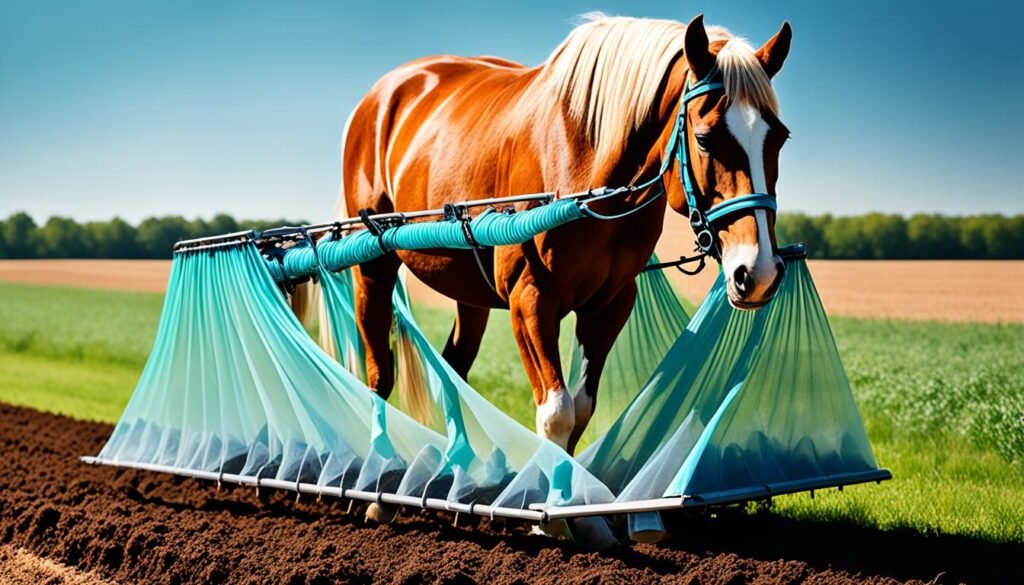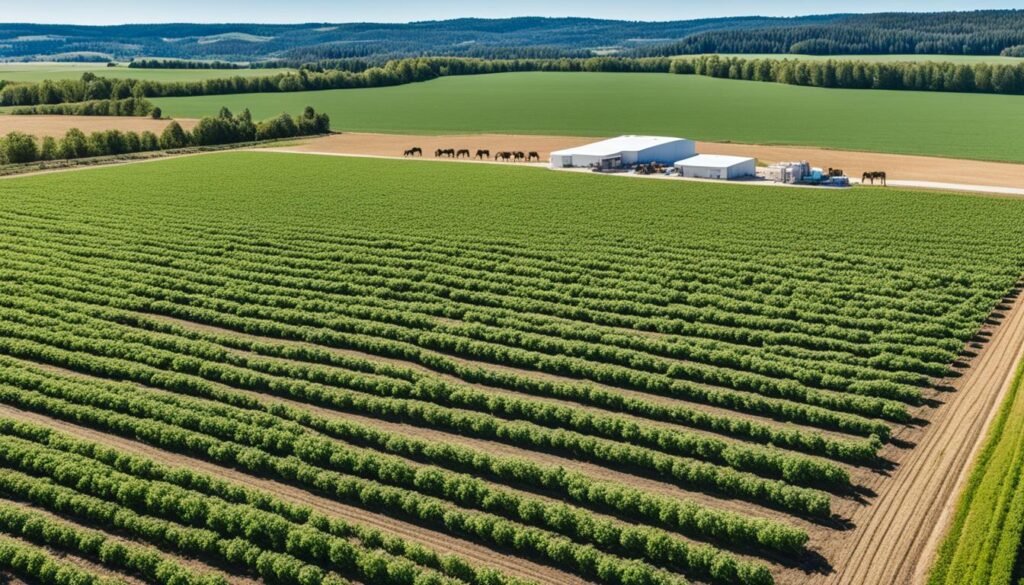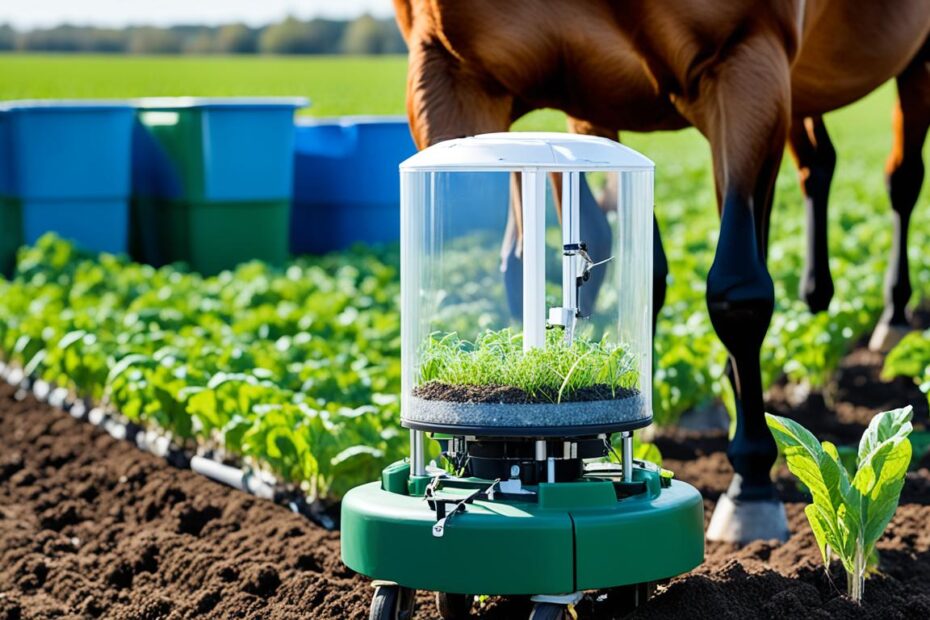In the face of the growing global crisis of microplastic pollution, researchers are turning to an unlikely source of inspiration: the humble horse. These majestic creatures, with their intricate evolutionary adaptations, may hold the key to unlocking sustainable solutions for removing harmful microplastics from agricultural ecosystems.
Known as “equine biomimicry,” this innovative approach explores the unique physical and behavioral characteristics of horses to develop innovative strategies for tackling the microplastics menace.
By studying the horse’s natural filtration mechanisms, waste processing abilities, and grazing habits, scientists are uncovering nature-inspired solutions that could revolutionize the way we address the escalating problem of microplastic contamination in our farmlands.
As the global agricultural industry grapples with the growing threat of microplastic pollution, the potential of equine biomimicry offers a glimmer of hope.
This article delves into the fascinating intersection of horse-inspired strategies and sustainable agriculture, exploring how we can harness the power of nature to safeguard our precious farmlands and secure a healthier future for our planet.
Key Takeaways
- Equine biomimicry explores the unique adaptations of horses to develop sustainable solutions for microplastic removal in agriculture.
- Researchers are studying the horse’s natural filtration mechanisms, waste processing abilities, and grazing habits to inspire innovative strategies.
- Harnessing the power of nature-inspired solutions could revolutionize the way we address the escalating problem of microplastic contamination in farmlands.
- Equine biomimicry offers a promising approach to tackle the growing global crisis of microplastic pollution in the agricultural sector.
- Integrating horse-inspired strategies into sustainable farming practices could promote environmental conservation and soil health.
Biomimicry: Unlocking Nature’s Secrets
In the realm of equine biomimicry, researchers are exploring the evolutionary adaptations of horses to inspire innovative solutions for modern environmental challenges.
By studying the unique physical and behavioral traits of these majestic creatures, scientists are uncovering nature-inspired solutions that hold the promise of transforming sustainable farming practices.
Exploring Equine Evolution for Environmental Solutions
The equine species have evolved over millions of years, developing remarkable abilities to navigate diverse terrains and thrive in a variety of ecosystems.
From their efficient locomotion to their resilient digestive systems, these animals possess a wealth of adaptations that can be studied and applied to solve pressing environmental issues, such as the growing problem of microplastic pollution in agricultural fields.
Adapting Nature’s Marvels to Modern Challenges
By observing and mimicking the strategies employed by horses, researchers are uncovering innovative bioremediation techniques that hold the potential to address the accumulation of microplastics in soil.
These sustainable farming practices harness the power of natural processes, drawing inspiration from equine evolution to develop eco-friendly solutions that can restore soil health and safeguard the environment.
| Equine Adaptation | Potential Environmental Application |
|---|---|
| Efficient Digestive System | Microbial decomposition of microplastics in soil |
| Robust Hoof Structure | Innovative soil aeration and microplastic disruption |
| Versatile Grazing Behavior | Targeted removal and dispersal of microplastic pollution |
By unlocking the secrets of equine evolution, scientists are paving the way for a future where nature-inspired solutions become the cornerstone of sustainable farming practices, empowering us to address the pressing challenges of our time.
The Microplastics Menace in Agriculture
The agricultural industry has become increasingly entangled in the growing crisis of microplastic pollution. Microplastics, tiny plastic particles less than 5 millimeters in size, have permeated our soils, posing a significant threat to soil health and the overall environmental impact.
Understanding the Impact of Microplastic Pollution
Microplastic pollution in agricultural fields can have far-reaching consequences. These minuscule particles can accumulate in the soil, disrupting the delicate balance of nutrients and inhibiting the growth of beneficial microorganisms. This, in turn, can lead to reduced crop yields, diminished soil fertility, and a cascading effect on the entire ecosystem.
Agroplastic Waste: A Growing Concern
Alongside the issue of microplastic pollution, the agricultural industry also grapples with the mounting challenge of agroplastic waste. Items like plastic mulch, irrigation components, and other agricultural plastics are increasingly finding their way into the soil, adding to the microplastics crisis. Proper disposal and recycling of these materials are crucial to mitigate their environmental impact.
Addressing the microplastic pollution and agroplastic waste problems in agriculture requires a multifaceted approach, combining innovative solutions and sustainable practices.
Exploring nature-inspired strategies, such as those inspired by horses, may hold the key to tackling this pressing challenge and safeguarding the health of our soils for generations to come.
Horse-Inspired Strategies for Microplastic Removal in Agricultural Fields
In the pursuit of sustainable agriculture, researchers are turning to an unlikely source of inspiration: the humble horse. By studying the adaptations and behaviors of these majestic creatures, scientists are uncovering innovative strategies to tackle the growing problem of microplastic pollution in agricultural fields.
Microplastics, the tiny fragments of plastic that accumulate in soil, pose a significant threat to soil health and crop productivity.
These microscopic particles can disrupt nutrient cycling, inhibit plant growth, and even make their way into the food chain. Identifying effective and eco-friendly solutions to this challenge has become a pressing priority for farmers and environmental experts alike.
Enter the realm of equine biomimicry, where researchers are closely observing the mechanisms horses use to thrive in their natural environment. From their efficient digestive systems to their resilient hooves, these animals possess unique adaptations that could hold the key to microplastics remediation and sustainable agriculture.
One promising approach inspired by horses is the use of bioremediation techniques to break down and remove microplastics from the soil. By harnessing the power of specialized microorganisms, scientists are exploring ways to harness natural decomposition processes to tackle the microplastics menace.
As the exploration of horse-inspired strategies for microplastic removal in agricultural fields continues, the potential for transformative solutions is both exciting and promising. By unlocking the secrets of equine adaptations, we may just find the path to a more sustainable and resilient agricultural landscape.

Equine Biomimicry: A Sustainable Approach
In the quest for sustainable solutions to the pressing issue of microplastic pollution in agricultural fields, researchers are turning to an unlikely source of inspiration: horses.
The concept of equine biomimicry has gained traction as scientists explore how the unique characteristics and adaptations of these majestic animals can be leveraged to develop innovative and eco-friendly strategies.
Horses are renowned for their remarkable resilience and adaptability to diverse environments. By studying their natural behaviors, researchers have uncovered a wealth of insights that hold the potential to revolutionize sustainable agriculture practices.
From their intricate digestive systems to their efficient locomotion, these equine marvels offer a treasure trove of biomimetic possibilities.
One particularly promising area of exploration is the role of horses in soil health and nutrient cycling. Horses’ efficient digestion and the subsequent breakdown of organic matter in their waste offer a model for developing bioremediation techniques to address the persistent problem of microplastic contamination.
By harnessing the power of natural decomposers, such as the microorganisms found in horse manure, researchers aim to create regenerative farming practices that can effectively remove and break down these harmful particles.
| Equine Characteristic | Sustainable Application |
|---|---|
| Efficient Digestion | Bioremediation of microplastics through manure-based decomposition |
| Adaptability to Diverse Environments | Developing robust, resilient farming systems that can thrive in challenging conditions |
| Hoof Structure and Locomotion | Inspiration for innovative tilling and soil aeration techniques to enhance soil health |
By embracing the principles of equine biomimicry, farmers and researchers are exploring sustainable pathways to address the growing threat of microplastic pollution in agricultural fields.
This innovative approach not only holds the promise of restoring soil fertility and biodiversity but also has the potential to reduce reliance on harmful agrochemicals, ultimately paving the way for a more regenerative and environmentally conscious future in agriculture.
Regenerative Farming and Soil Health
As we explore the potential of horse-inspired strategies for tackling the microplastic crisis in agriculture, it’s essential to consider the broader context of sustainable farming practices.
Regenerative farming has emerged as a holistic approach that not only addresses environmental challenges but also nurtures the very foundation of our food systems – the soil.
Preserving Soil Fertility and Biodiversity
Regenerative farming emphasizes the importance of maintaining soil health and biodiversity. By mimicking natural ecosystems, these practices aim to rebuild the rich tapestry of life beneath our feet.
Through techniques like cover cropping, minimal tillage, and integrating livestock, farmers can enhance the soil’s ability to sequester carbon, retain moisture, and support a thriving community of microorganisms and pollinators.
This, in turn, strengthens the resilience of the entire agricultural system, making it better equipped to withstand the impacts of climate change and environmental degradation.
Reducing Agrochemical Dependence
Inherent to the principles of regenerative farming is the goal of reducing reliance on agrochemicals, such as synthetic fertilizers and pesticides. By nurturing the natural fertility of the soil and fostering diverse ecosystems, these practices can help mitigate the need for costly and harmful inputs.
This not only benefits the environment but also improves the overall profitability and sustainability of farming operations, creating a win-win scenario for both farmers and the planet.
| Regenerative Farming Practices | Benefits |
|---|---|
| Cover Cropping | Improves soil structure, increases organic matter, and suppresses weeds |
| Minimal Tillage | Preserves soil microbiome and reduces soil erosion |
| Integrated Livestock | Enhances nutrient cycling and contributes to a diverse agroecosystem |
By embracing regenerative farming practices, we can not only address the microplastic challenge but also cultivate a more resilient and sustainable agricultural landscape, one that nourishes both the soil and the communities it serves.
Bioremediation Techniques for Microplastics
As the agricultural industry grapples with the growing challenge of microplastics contamination, researchers are turning to nature’s own decomposers for sustainable solutions.
Bioremediation techniques, inspired by the natural processes observed in horses and other organisms, hold the key to effectively removing and decomposing these persistent pollutants from agricultural soils.
Harnessing Nature’s Decomposers
Microorganisms, such as bacteria and fungi, are the unsung heroes in the fight against microplastics. These microscopic decomposers possess the remarkable ability to break down and assimilate various types of plastic waste, including the ubiquitous microplastics that have infiltrated our agricultural ecosystems.
Through innovative bioremediation approaches, scientists are leveraging the innate capabilities of these natural decomposers to tackle the microplastics menace.
By cultivating specific microbial strains and optimizing the environmental conditions, researchers are developing effective strategies to accelerate the degradation of microplastics in the soil, ultimately restoring soil health and promoting sustainable environmental conservation.
- Isolating and cultivating plastic-degrading microorganisms
- Designing bioreactors and composting systems to enhance bioremediation techniques
- Optimizing nutrient and environmental conditions for efficient microplastics remediation
- Exploring synergistic interactions between microbes and other natural decomposers
By harnessing the power of nature’s decomposers, the agricultural industry can unlock new pathways to address the soil health challenges posed by microplastics, paving the way for a more sustainable and resilient future.

Case Studies and Success Stories
The journey towards sustainable agriculture has been marked by remarkable success stories that showcase the power of equine biomimicry in addressing the microplastics menace. Let’s explore a few inspirational case studies that illustrate the practical implementation and tangible benefits of these innovative techniques.
In a small farming community in the Midwest, a family-owned operation has embraced the principles of regenerative farming and incorporated equine-inspired strategies for microplastics remediation. By leveraging the natural abilities of horses, they have developed a unique soil-tilling system that effectively removes and captures microplastic particles from their fields.
The results have been nothing short of remarkable, with a significant reduction in agroplastic waste and a visible improvement in soil health and fertility.
Across the Atlantic, a pioneering organic vineyard in Italy has pioneered the use of equine-inspired bioremediation techniques to address the challenge of microplastics in their soil. By harnessing the power of nature’s decomposers, they have successfully implemented a method that utilizes the unique digestive capabilities of certain equine species to break down and eliminate microplastic contaminants.
The transformation of their vineyards has not only enhanced the quality of their grapes but also contributed to a more sustainable and regenerative agricultural ecosystem.
In a coastal region of Australia, a resilient farming community has embraced the principles of sustainable agriculture, incorporating equine biomimicry as a central component of their microplastics remediation efforts.
Through innovative soil management practices inspired by the adaptations of horses, they have been able to effectively trap and remove microplastic particles from their fields, ensuring the long-term health and productivity of their land.
These inspiring case studies demonstrate the transformative power of equine biomimicry in addressing the microplastics challenge and promoting sustainable agriculture.
By harnessing the unique abilities of horses and adapting their natural strategies to modern farming practices, these pioneers are paving the way for a more resilient and regenerative future for our agricultural systems.
Overcoming Challenges and Limitations
As we explore the exciting prospect of harnessing horse-inspired strategies for microplastics remediation in agricultural fields, it’s crucial to address the potential challenges and limitations that may arise.
Scalability and cost-effectiveness are two key considerations that need to be carefully examined to ensure the widespread adoption of these sustainable solutions.
Addressing Scalability and Cost-Effectiveness
One of the primary hurdles in implementing horse-inspired microplastics removal techniques is the issue of scalability. While these methods may work effectively in small-scale trials, the ability to replicate and scale up the processes for larger agricultural operations is a crucial factor.
Researchers and practitioners must explore innovative ways to streamline the application of these strategies, ensuring that they can be seamlessly integrated into existing farming practices without significantly disrupting operations.
Another important consideration is the cost-effectiveness of these solutions. Farmers and agricultural stakeholders will be more inclined to adopt these methods if they prove to be financially viable in the long run.
Careful analysis of the upfront investments, maintenance costs, and potential cost savings or benefits associated with improved soil health and sustainable agriculture practices will be crucial in determining the feasibility and scalability of horse-inspired microplastics remediation.
By addressing these challenges head-on and finding creative solutions, we can pave the way for the widespread adoption of horse-inspired strategies, ultimately contributing to a more cost-effective and scalable approach to addressing the pressing issue of microplastics remediation in agricultural fields.
Policy and Regulatory Frameworks
As the world grapples with the escalating issue of microplastic pollution, policymakers and regulators play a crucial role in fostering sustainable agricultural practices that mitigate this environmental threat.
By enacting targeted policies and regulations, governments can enable the widespread adoption of innovative, horse-inspired strategies for removing microplastics from agricultural fields.
Promoting Sustainable Agriculture
Sustainable agriculture is at the heart of these policy initiatives, which aim to reduce the reliance on synthetic chemicals and promote environmentally-friendly farming methods. Regulations that incentivize the use of bioremediation techniques and biomimicry-inspired solutions can help drive the transition towards a more sustainable agricultural landscape.
Policies that encourage the implementation of regenerative farming practices, such as crop rotation, cover cropping, and reduced tillage, can also contribute to the prevention and mitigation of microplastic contamination in soil.
By preserving soil health and biodiversity, these approaches can minimize the impact of agrochemical waste and support the natural decomposition of microplastics.
Fostering Environmental Conservation
Alongside sustainable agriculture, policy and regulatory frameworks must also address the broader issue of environmental conservation. Measures that protect natural habitats, promote biodiversity, and limit the use of single-use plastics can have a cascading effect on reducing microplastic pollution in agricultural systems.
By aligning policy with the principles of circular economy and emphasizing the importance of waste management, policymakers can create an enabling environment for the successful implementation of horse-inspired microplastics remediation strategies in agricultural fields.
Conclusion
In this insightful article, we have explored the remarkable potential of horse-inspired strategies to revolutionize the removal of microplastics in agricultural fields. By drawing inspiration from the evolutionary adaptations of equine species, we have discovered innovative solutions that hold the key to a more sustainable and environmentally conscious future for farming practices.
The principles of equine biomimicry have demonstrated the power of nature to provide us with the answers we seek.
From harnessing the natural decomposition processes observed in horses to developing regenerative farming techniques, these strategies offer a promising path forward in addressing the growing challenge of microplastic pollution in our agricultural ecosystems.
As we move forward, it is essential that we continue to investigate and implement these horse-inspired solutions, fostering a deeper understanding of how we can leverage the wisdom of nature to protect our precious soil, promote biodiversity, and ensure the long-term viability of our food production systems.
By embracing the lessons of the equine world, we can unlock a more sustainable and resilient future for our agricultural landscapes, ultimately contributing to the preservation of our planet’s delicate environmental balance.
FAQ
What is the main focus of this article?
The article explores innovative horse-inspired strategies for removing microplastics from agricultural fields, utilizing the concept of equine biomimicry to develop sustainable solutions for this growing environmental challenge.
What is the role of biomimicry in this context?
The article examines how researchers are studying the unique adaptations and behaviors of horses to unlock nature’s secrets and apply these principles to address the problem of microplastic pollution in farming ecosystems.
What is the impact of microplastic pollution on agriculture?
The article delves into the growing problem of microplastic pollution in agricultural fields, highlighting its negative impacts on soil health, crop productivity, and the broader ecosystem. It also discusses the increasing concerns around agroplastic waste and its contribution to the microplastics crisis.
How are horse-inspired strategies being used for microplastic removal?
The article introduces the exploration of horse-inspired strategies for removing microplastics from agricultural fields, leveraging the unique adaptations and behaviors of horses to develop sustainable solutions for this environmental challenge.
What is the role of equine biomimicry in sustainable agriculture?
The article examines how the concept of equine biomimicry is being applied to enhance soil health, reduce agrochemical dependence, and promote overall environmental conservation in agricultural practices.
How can bioremediation techniques inspired by horses be used for microplastics removal?
The article explores the potential of bioremediation techniques, inspired by the natural processes observed in horses and other organisms, to effectively remove and decompose microplastics in agricultural fields.
What are some real-world case studies and success stories related to horse-inspired strategies for microplastic removal?
The article presents case studies and success stories that showcase the practical implementation of horse-inspired strategies for microplastic removal in agricultural fields, highlighting the measurable outcomes in terms of improved soil health, reduced microplastic pollution, and enhanced sustainability of farming practices.
What are the challenges and limitations associated with implementing horse-inspired strategies for microplastic removal?
The article acknowledges the challenges and limitations related to the scalability, cost-effectiveness, and practical hurdles that need to be addressed to ensure the widespread adoption of these sustainable solutions.
How can policy and regulatory frameworks support the adoption of horse-inspired strategies for microplastic removal?
The article explores the role of policy and regulatory frameworks in fostering sustainable agricultural practices, including the implementation of horse-inspired strategies for microplastic removal in agricultural fields.

